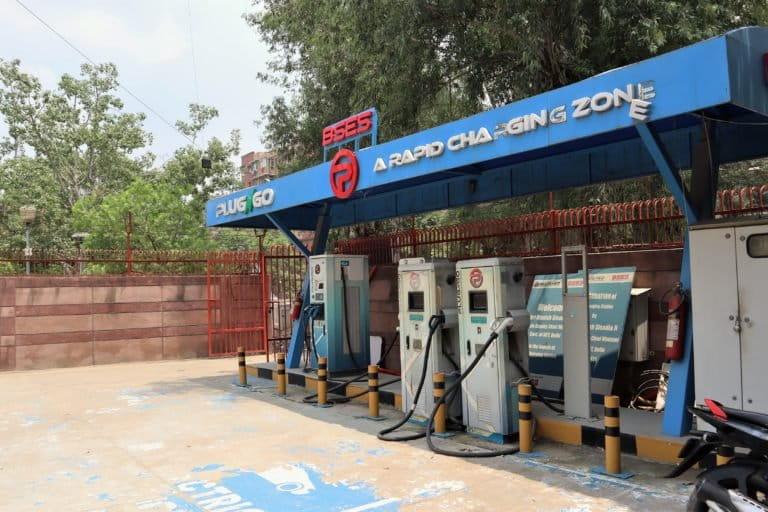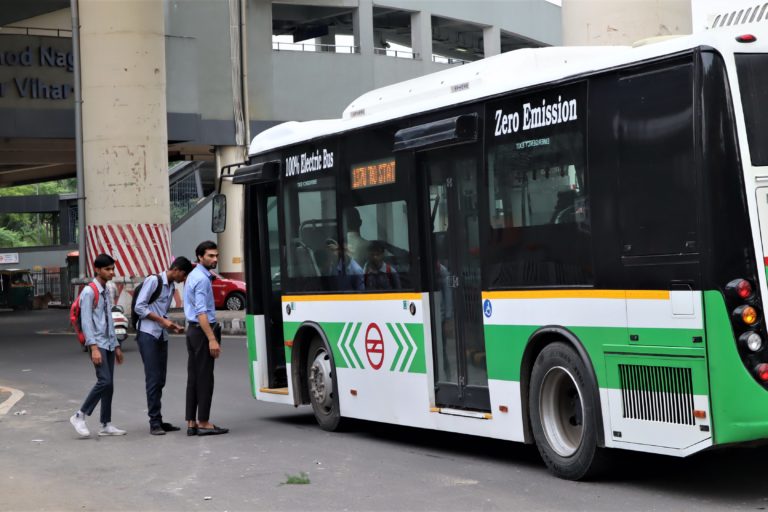- Delhi currently has 573 charging stations which give their services anywhere between Rs 10/unit-Rs 15/unit. The government recently started working towards 100 public charging stations where charging facilities could be available at as low as Rs 2/unit.
- E-rickshaw, e-autos and other last mile connectivity public transport systems in Delhi are largely dependent on the charging-cum-parking stations to charge their vehicles at higher prices. Many still use illegal, unauthorised power connections leading to losses to discoms.
- Delhi government with its Electric Vehicle Policy has planned to ensure 25 percent of the vehicle registrations from Electric Vehicle segment alone by 2024 while it has asked all cab aggregators and delivery services to ensure 100 percent of their new fleet to be electric only by 2030 with its anew draft aggregator policy.
After a lull due to the pandemic, sales of Electric Vehicles (EVs) in Delhi have surged and continue to rise. In 2022, breaking all previous records, the Union Territory reported a total of 25,890 sales of EVs in the first six months itself. This was the highest ever recorded, crossing annual sale numbers in previous years as well.
In Delhi, while privately-owned electric two-wheelers and four-wheelers are still popular, there is a growing interest in e-vehicles for commercial food deliveries, e-commerce website deliveries and porter services. There are also e-rickshaws, e-carts, e-bikes and even electric-only cab aggregator services that have emerged to reduce business input costs while simultaneously reducing carbon emissions from fuel-powered vehicles.
Take the case of BluSmart, a Gurgaon-based electric cab aggregator which started its business in 2019 with 70 electric cabs to cater to the travel needs of the people in the National Capital Region (NCR) and ensure an emission-free drive in the polluted streets of the national capital. Puneet Goyal, co-founder of the firm told Mongabay-India that now the firm has more than 1,800 cabs and is expanding its fleet up to 5,000 cars in the next few years. The rising awareness among consumers is helping the EV-based service expand its business in the city.
Goyal said they have installed 1,400 charging points across NCR for their own EV charging needs. He said that the support for EVs under the FAME-II scheme of the union government and reduced tariffs for EVs from the Delhi government have helped boost EV-based services. In addition to BluSmart, other players in Delhi such as eee-Taxi and Prakriti E-mobility also have e-cab services.
Similarly, food and grocery delivery service providers like Zomato, Swiggy, Zepto, BlinkIt and others are transitioning to captive electric scooters (scooters used for their inhouse work) for last mile deliveries (the last leg of the delivery journey to the doorstep of the customer). Most of them have their own on-campus charging stations to keep their businesses going without depending on public or private charging stations.
The Delhi government, on July 5, also came up with the draft Delhi Motor Vehicle Aggregator Policy to regulate vehicle aggregators engaged in passenger transport including delivery partners. Under the policy, the aggregators have been asked to transit to electric mobility in a phased manner; otherwise they could be penalised.

According to the policy, the aggregators must ensure that all of the new registrations by 2030 should come from electric vehicles. There are also 2023 targets for electrification for different categories of aggregators, identified in the policy.
Charging woes for e-rickshaws
While electric vehicles of all kinds are becoming popular, the charging infrastructure is still to keep up. While the commercial and private four-wheelers and two-wheelers have set up charging facilities either at their offices or homes, the e-rickshaws and e-carts, however, are struggling to meet their charging needs as they are highly dependent on parking-cum-charging stations where they shell out up to Rs. 3000-Rs. 4000 per month to charge their vehicles.
Pawan Kumar, a manual rickshaw puller in Jagatpuri in Delhi, used his rickshaw to transport tiles for construction. However, due to the manual labour required in operating the rickshaw, his work was limited to a few hours a day. This year, he started driving an electric cargo three-wheeler given by his employer. With this transition, he earns more, but still remains dependent on private charging-cum-parking stations for charging the vehicle. “Switching from manual rickshaw to an electric carrier helped me to earn up to Rs. 15,000 per month and also devote more time to my work as it is not very labour intensive now. Earlier I used to earn around Rs. 10,000. I carry tiles from godowns to the client sites. As many e-rickshaw drivers do not have good electricity supply to charge their vehicles at home, we have to give it to parking-cum-charging stations where they are charged at night. Majority of the e-rickshaws and e-carts do the same. These charging stations cost around Rs. 3000 per month,” he told Mongabay-India.
Ramesh Yadav, who runs an e-rickshaw at IP Extension Metro Station in Delhi, said that the cost of charging at such centres is in addition to the other monthly maintenance cost of these vehicles and claimed that if the government could come up with a good number of low-cost public charging stations, it could help rickshaw drivers like him to reduce their input costs and increase their earnings.
“In Delhi if you opt for any charging station, most of them are private where charges ranging from Rs. 10 per unit to Rs. 50 per unit based on electricity supply and pace of charging. If the government could consider expanding low-cost public charging stations, it could help many e-rickshaw drivers reduce their monthly charging costs,” he said.
Another e-rickshaw driver Ramanath Prasad said that even the present number of charging stations in Delhi are not in good numbers. Moreover, many private charging stations have been designed specially for four-wheelers.
As a fall out of the costs of charging e-rickshaws, power theft and unauthorised use of electricity for charging these rickshaws is becoming common in Delhi, leading to losses for the electricity distribution companies (discoms). According to government estimates, unauthorised charging of e-rickshaws in Delhi led to a loss of around Rs. 150 crore annually for discoms. E-rickshaws use around 7-10 units of electricity to charge their vehicles fully, but due to the lack of adequate and cost-effective public charging stations they are paying around Rs. 100-Rs. 150 per day at most of the unregulated parking-cum-charging stations. On the other hand, the Delhi Electricity Regulatory Commission (DERC) tariff for separate EV chargers for households stands at Rs 4.5 per unit, one of the lowest in the country. This also comes with one time financial support from the Delhi government, but very few e-richshaw, e-auto and e-porter drivers avail this due to lack of awareness and lack of parking areas in their residential areas.
There is hope though in the near future as the Delhi government has recently started working on 14 new public charging stations on cluster basis where the public charging facilities will be available for as low as Rs. 2 per unit against the existing higher tariffs. While work on 14 stations is reported to have started, a total of 100 such stations are expected to come up by September this year. As per the government statistics, Delhi currently has 573 charging stations in total (private and government) with 812 charging points and 318 battery swapping stations.
Electric public transport slowly catching up
Electric-based public transport is also getting a boost in Delhi. The Delhi Metro Rail Corporation (DMRC), after observing poor interest in feeder bus services has decided to launch 50 e-rickshaws as feeder services for the last mile connectivity in the first phase of this effort to boost public transport usage.

Spurthi Ravuri, Senior Associate at the Centre for Study of Science, Technology and Policy (CSTEP) said that there needs to be greater attention on public transport to tackle pollution in Delhi. She said, “Since the notification of the EV policy in 2020, the state has seen an increase of over 100 percent in EV sales (from around 12,000 registrations in 2020 to around 25,000 in 2021). The state has witnessed about eight percent of total EV sales in the last financial year. The implementation of the NITI Aayog’s Battery Swapping Policy will attract more commuters to opt for EVs.”
She also added, “Achieving the 25 percent sales target by 2030 would help Delhi avoid about 5 metric tonnes of carbon dioxide emissions. The current congestion in Delhi is at 48 percent, that is, it takes 48 percent more time to travel during peak congested conditions compared to non-congested conditions. To address these issues, the focus should be on shifting to electric public transport.”
In terms of electrification of Delhi’s public buses for example, the pace is slow – the city currently has only a total of 150 electric buses plying on the roads. The Delhi Transport Corporation (DTC) has planned to ready 1,800 electric buses by the end of 2023 which includes 1,500 electric buses, through the central government’s Grand Challenge Scheme.
Ashish Kundra, Delhi Transport Commissioner recently announced that the government would give 50 percent subsidy to women drivers who undertake electric vehicle driving training at government-run training centres whereas the Delhi government has also planned to ensure 75 percent of their 5,500 fleet of government buses are electric vehicles by 2025.
When approached by Mongabay-India, the DTC and the Delhi Transport Department did not respond to queries related to the pace of introducing EVs in public transport in Delhi or the charging infrastructure. Emails sent to the higher officials to the departments also did not elicit any response.
Banner image: An e-rickshaw near the East Vinod Nagar metro station in New Delhi. Photo by Manish Kumar/Mongabay.













